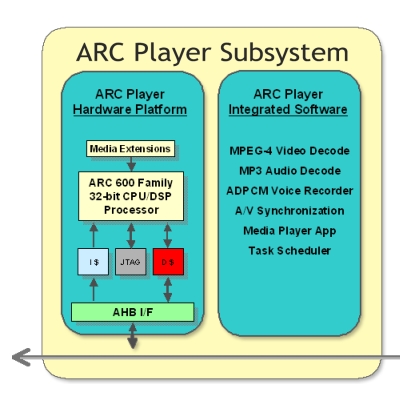On September 9th, silicon intellectual property licensor ARC made two related announcements: It unveiled a new configurable multimedia player subsystem based on its ARC600 family of cores, and announced a new partnership with Chinese silicon foundry Semiconductor Manufacturing International Corp. (SMIC). Under ARC's agreement with SMIC, ARC licensees that design chips in China and use SMIC for fabrication will pay no up-front licensing fees, paying royalties only when their chips start volume production, and will receive a discount on development tools and support. SMIC will also provide hardened versions of ARC's configurable cores.
The new player subsystem, shown in Figure 1, features an ARC600 family 32-bit RISC CPU with multimedia extensions. Mainly targeting inexpensive portable audio/video players and low-end cell phones, the subsystem is intended to provide designers with a low-power, low-cost solution that can be incorporated with minimal development effort. According to ARC, in a 180 nm TSMC G process that ARC claims is equivalent to SMIC's 180 nm process, the subsystem will have a silicon area of 3.5 mm^2 and achieve a clock rate of 160 MHz. The company also reports that an audio/video player application with MPEG-4 decode, MP3 decode, audio/video synchronization, and player interface, consumes 125 MHz and has power consumption of 150 mW. ARC provides audio decoder software for MP3, WMA, AAC, and AC-3, as well as an MPEG-4 video decoder supporting QCIF resolution. When asked about other video standards such as H.264, Dan Davis, director of multimedia solutions at ARC replied, "We have code for the other codecs such as H.264, VC-1, MPEG-2, etc.... It's a question of what the customer is willing to live with in their MHz budget. We think MPEG-4 is the right solution." Customers may fabricate their chip at smaller process nodes and achieve higher clock rates, which may be necessary to implement more complex algorithms like H.264, but it is expected that SMIC will only offer hardened cores at 180 nm.

Figure 1. Very high-level diagram of the ARC player subsystem and software offerings.
ARC licensees that design their chips in China and use SMIC for fabrication are also eligible for a discounted package of tools and support that includes an FPGA development platform, reference code, product updates and bug fixes for 12 months, 40 hours of technical support, and a single seat in ARC's training course. The discounted package will cost sixty-six thousand dollars. Licensees that don't use Chinese design houses and SMIC will be subject to ARC's usual fees for IP and support services.
ARC's new offering is clearly intended to give Chinese chip companies an inexpensive path to incorporating the ARC player subsystem into their designs. It is notable that ARC is aggressively marketing its intellectual property in China, something that many IP companies have been reluctant to do for fear of piracy. For chips destined for the U.S. market, ARC may have some protection from the U.S. International Trade Commission (ITU). In a recent ruling the ITU found Action Semiconductor, a Chinese chip-maker, guilty of infringing two patents held by US chip-maker SigmaTel. As a result, MP3 players containing the 207X, 208X and 209X chips from Action Semiconductor were banned from entry into the US.
The synthesizable ARC player is available now. The player in hard-core form is slated for release in mid-2007.


Add new comment